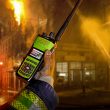ATIS outlines guidelines for service providers, PSAPs to reduce 911 outages
From TMCnet.com: Risks of overloading 911 systems during weather or other emergencies is increasing thanks to the changing call patterns including increased traffic on wireless networks, finds a report from Alliance for Telecommunications Industry Solutions (ATIS).
The review analyzed why certain trunk lines serving PSAPs were being removed from service during heavy calling volumes.
When call volume increases, “wink” failures can occur between service providers’ selective routers and PSAPs that temporarily disrupt trunk lines. A wink is defined as a short signal carried over the network at the beginning and end of calls.
ATIS’ report has outlined a set of recommendations to prevent these types of outages. It says service providers modifying their selective routers must prevent complete trunk groups from going out of service due to double wink failures.
The second recommendation states PSAPs and service providers working together must develop overflow routing to backup PSAPs during high call volumes. They must also facilitate increased communications between service providers and PSAPs during high volume periods to minimize impact, the third recommendation stated.
Lastly ATIS suggests updated procedures that would allow PSAPs to handle more calls during high volume periods must be adopted. This could include employing more call-takers during expected weather emergencies or shifting focus to handling as many calls as possible rather than returning calls during these volume periods. Read the entire article here.

















